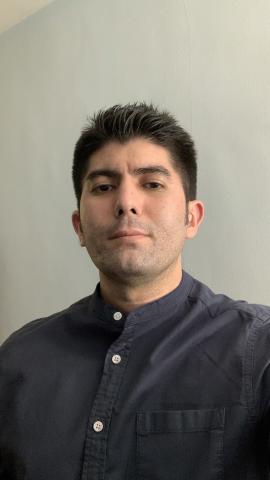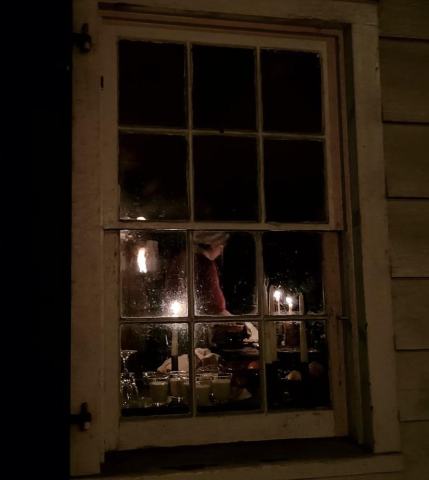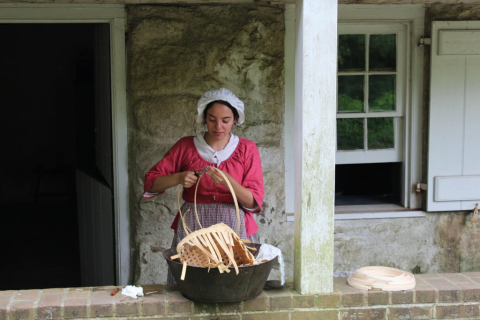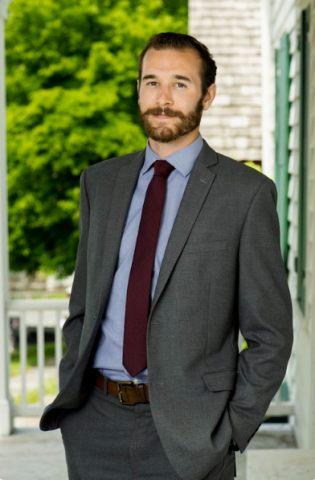Becoming public historians: Our students speak
Public history students reflect on what sparked their passion for public history and how the advanced certificate is helping them reach their goals.
Blog Posts
Faruh Davletov: My Journey Toward Public History

My Journey Toward Public History
Faruh Davletov
Having an almost 2-meter-high image of Bruce Lee in a fighting pose, as well as Schwarzenegger’s Terminator, Stallone’s Rocky, and Van Damme’s Double Impact posters, I had such a fascination of these figures during my childhood years. It has been thirty-five years, but I still remember images of these American stars posted onto the wall in my brother’s room. As a small kid, I frequently stared at those images, and I enjoyed watching these stars on VHS cassettes. My brother brought these cassettes home from the video salons that were popular in the early 1990s post-Soviet space. All I can say now is that I felt excited about these action stars’ images unconsciously and probably could not even imagine that this weird interest would evolve into something different.
Before my adolescent years, I was literally stuck to our TV and watched various cartoons, shows, and films. Most of my interest was in various films with content one way or another related to history. They were fictionalized historical movies, mostly from the Soviet era as well as some new ones. I liked watching them because I enjoyed seeing the way people communicated on the screen, the fashion styles they preferred, and how they determined their lifestyle in their past and current moments.
These types of expressions seem far off from historical perspectives, but it could have some invisible connections with history. Individuals, youngsters especially, vividly reflect the main and current trends in society in the clothes they wear, conversations they have, and ideologies they prioritize. Society, on the other hand, is influenced by cultural tendencies dictated by political and historical events and figures that then become a part of the world and local history.
Having found such a connection, I ended up with my further interest in watching pure history movies, both fiction and non-fiction. In addition, my family moved to another city, which pushed me to intensely read history textbooks in my new high school. By doing so, I tried to understand historical processes and figures, how they developed and rose to power, and their consequences in how they were able to shape our present and the mindset of the people who surrounded me. At that moment, I could barely answer these questions, most likely due to my young age and short-lived experience.
As an adult man and a college student in the United States, I can rethink and reconsider a lot of priorities in my life. It includes what profession to choose, and upon looking back on what impressed me much in my life, I recalled those posters from my brother’s room. Then I realized that it was actually a launchpad for my career choice that led me to a decision to study public history. These posters from my childhood sparked an interest for action movies, especially in a space where my previously isolated country was emerging out of communism in which most universal entertainment was banned; to elaborate, my parents grew up in a fully Soviet society and as a child, I grew up during this transition where movies, and even music, from all over the world began being introduced in my society which caused me to feel extremely intrigued with them. It was later as I began learning about my country’s own history that I grew fascinated with the historical and cultural influences that shaped those movies. I began asking myself, how was it that that movies could have so many themes and depictions, such as the ways they dress, spoke, that seemed so different from the ones my country had? The more I thought about it, I realized that these depictions were not only so different, but they also challenge Soviet ideology which is why we never had those types of media in the first place. Being exposed to this media caused people to think in more ways outside of the communist system. The connection between my childhood posters and my desire to do a public history degree is not direct but one sequence did lead to another throughout my personal and academic journey. The view of historical influences from the pop-culture perspective eventually brought me to study Public history because I have the desire to make my research accessible for anyone to read.
Today, I am studying history in a Master of Arts program that focuses on public history. I currently think that public history is a unique discipline in history that would allow me to distribute the results of my studies to a wider audience. Such outreach would be possible due to publishing books, as well as in digital and participatory platforms with worldwide access.
Another public history tool will be the presentation of my research through conferences and meetings in museums and related institutions. All these innovations would highly increase the chances to be noticed by other people at a larger scale.
Public history’s modern tools shape today’s subjects of history and make it a desirable career choice for a larger number of people. With the help of carrying research and studies in history through public history, I would be able to better synthesize my academic research regardless of what type of issue or topic I aim to raise. As my brother’s posters sparked my interest in doing public history, the visualization of academic history with intellectual content would capture more viewers and simply curious people who would find it interesting and devote their lives to studying history.
– Faruh Davletov, Student of Master of Arts at CSI History Department
Selena Ditre: Living a Historic Life
Living a Historic Life
Selena Ditre
History has been an interest of mine for as long as I can remember. As a child, I would beg my parents to take my siblings and I to museums and would spend hours on the internet looking up any historical topic I came across through movies or television. A particular interest I had was living history. It fascinated me that people were able to recreate the past and bring it to the modern world. I think a part of me is still fascinated by it. A class trip to Historic Richmond Town (Staten Island, New York) in 2006 pushed this curiosity further when I saw the historical interpreters demonstrating the trades of the 1800s. At the time, I did not realize how much of an impact this school trip had on my life. It was not until fifteen years later, when I began working there in 2021,that I saw how much of an impact it had on me.
Through high school, I had applied to Historic Richmond Town a few times (as well as other museums) and was rejected each time. This deterred me from wanting to pursue a career in museums and instead decided I was going to go to college for secondary, special education in history. I ended up disliking education, dropped it and stuck with history. I was still strongly intimidated by the idea of working in museums. After I graduated with a Bachelor's degree in history, I decided to not let the intimidation deter me from museums and started applying to various internships. I was able to secure a research internship with the National Lighthouse Museum in Staten Island, New York and realized I had no reason to be intimidated by the field of work I wanted to do.
During my five month run at the National Lighthouse Museum, I learned so much and wore many different hats within my internship role. I honestly loved it. With my new found confidence in the field, I decided to apply to various museums in various positions, one being historical interpreter at Historic Richmond Town. This application intimidated me, for I had already been rejected and it was a position that required me to engage with public speaking, which frightened me greatly. Though the intimidation was strong, I remembered how badly I wanted this position and was confident that, like the National Lighthouse Museum, I could learn and do the job efficiently.
Much to my surprise, I received a phone call while on the way to my retail job, offering me the position as historical interpreter at Historic Richmond Town. I started my training the next week and was eager to learn the position and start a trade. I tackled my fear of public speaking and fell in love with my job and the field of public history in general. Within this position, I was able to live a lot of childhood dreams, one being just being able to dress up in period clothing and do a trade. I currently do basketmaking and hearth cooking. Another one is brick oven bread baking. As a child, I was obsessed with the movie Kiki's Delivery Service (Studio Ghibli, 1989) and in the movie, there is a scene where a character named Fukuo is baking bread in a brick oven. I used to watch the movie over and over wanting to use a brick oven so badly. At Historic Richmond Town, I was able to do it.
As time went on in my position, I knew I did not want to stay in museum education forever and had a difficult time finding another position without a higher degree. I found curation to be an interesting line of work and decided this would be my next career goal. This pushed me to further my education and I am currently enrolled in the College of Staten Island's Advance Certificate in Public History program. My current goal is to do curatoration at Historic Richmond Town.
Historic Richmond Town has made a profound impact on my life, an impact I did not realize until I began in the field of public history. From way back during the first field trip I took there, to the countless visits I had there through my childhood, it has given me the opportunity to find a career path I genuinely enjoy and has made me a career driven person

.

Ian Hagens: My Path to Public History

My Path to Public History
Ian Hagens
History has always been my interest. Ever since I was a kid, I was glued to my grandfather, who always had a story about some piece of history or some figure he admired from American history. Family has always played a part in my appreciation of history, on my other side of the family, my Aunt Maurine, who I call Mo Mo, has been spending her retirement digging around in the archives of the Jersey City Historical Society and unearthing all of these fascinating pieces of our heritage in that city. It’s interesting to find out a new tidbit about where her grandfather made donations that earned small placards that the family has forgotten about over the decades, only to be unearthed again.
I may be living on Staten Island, but I’m a Jersey boy through and through. I’ve grown up close to Morristown, which has a rich history especially in regard to the Revolutionary War. Since I was a kid, I grew up with main thoroughfares in my town being named after familiar American commanders from the revolutionary war, because they were the same paths they reportedly walked while they were camped out in the area. I went to Lafayette Avenue School, which was named after General Layayette because it was his favorite path he took to water his horse each day.
Once I started my undergrad career, I believed with all my heart that I wanted to be a high school teacher. I had gone through the school system and had always had the most interest in the history classroom, so when I went off to college at Rowan University it felt like a good fit to take that on. I went through the majority of my undergrad with the idea that I would be working in a middle school or high school setting, but unfortunately the classroom just was not for me. The teacher lifestyle was a hard thing to mesh with my own and I bailed out of the intended education major. With a greater focus on history now in front of me I had time to shift my career path.
At first, I had no idea what I was going to do, and I was quite honestly panicked. I was able to settle my nerves after talking with some advisors and professors who pointed me in the direction of higher education and public history. I was not sold on it immediately, but it did grab my attention as something I could become very passionate about. I finished my undergrad degree at Rowan with a history major and education minor and went out to seek a job in museum education.
That first job outside of college, that wasn’t bussing tables or washing dishes, was with Historic Richmond Town. I had applied to a couple dozen jobs prior all around the area, but Historic Richmond Town looked at my resume and seemed immediately interested in hiring me. To be totally honest, that interview was the first time I had ever stepped foot on Staten Island, but I was immediately impressed with the place. Never in my wildest dreams would I have imagined I would be working at a living history museum such as what you find at Historic Richmond Town.
Once I had a starting job at Historic Richmond Town, it was off from there to build up my resume further. My professors’ advice of higher education in the back of my mind paired with my parents breathing down my neck to get a full time job in the field made for the perfect storm and I began to look around for a certificate in public history. The best option for myself seemed abundantly clear, I would study at the College of Staten Island.
The college is one of only a few that offers the certificate in public history in the city. It felt like a no brainer to apply for this certificate with CSI. Every aspect of the courses so far has had an impact with the work I do at Historic Richmond Town. I started my career in the education department, but have gained so much more appreciation of various other aspects of the field such as exhibit building and preservation. This program offered by CSI has helped me along in my professional development.
Gabriella Leone: Public Historians as Educators
Public Historians as Educators
Gabriella Leone
“The archives are an unimaginably magnificent wonderland,” responded my former teacher Christopher Franz when I wrote to him excitedly about an archival research visit. Mr. Franz taught me Church History in eleventh grade and one day he mentioned that Dorothy Day was buried in Resurrection Cemetery on Staten Island. Another day, he mentioned that General Santa Anna of Mexico lived for a time near Blessed Sacrament Church on Forest Avenue. Soon, I caught on that Mr. Franz knew a lot about Staten Island history and what’s more, that there was a lot to know about Staten Island history! That spark of curiosity has led me in unexpected and exciting directions, culminating in my current job as Archives Manager at the Staten Island Museum.
I was deeply influenced by my high school history teachers. Mr. Franz has become a mentor and I reach out to him for insight or advice even now. George Conlon, who taught me in the ninth grade, drew maps of the continents on the chalkboard adding geographic features and political boundaries by hand as he narrated the vicissitudes of global history and emphasized the interconnectedness of the world's people. “It’s cultural diffusion, ladies and gentlemen,” he would say as we examined cultural exchanges moving along trade routes and transferring in the friction of war. Charles Abruzzo passed out old copies of Voices of the American Past, anthologies of primary source documents about American history, and showed us how to analyze them. Who created the source? What was their purpose in writing it? What was their bias? I was so influenced by my high school teachers that I wanted to be one.
I loved teaching. I co-founded a peer tutoring group in high school, worked as a tutor in the writing center in college, and as a teaching scholar running small group tutoring sessions at Curtis High School. I loved being able to pass on the inquiry-based, problem-solving skills my favorite teachers taught me. “A scholar,” Mr. Franz said, “is not measured by the answers they already know, but by the questions they ask.” I completed all of the undergraduate coursework to become a middle or high school history teacher before deciding the New York City Department of Education wasn’t my ideal future employer. The final determining factor was the pragmatic way in which the student teaching seminar instructors announced that the learning objectives for the course were how to keep our heads down, get tenure, and secure our pensions.
Though I knew I was making the right decision for myself, I still felt heartbroken and adrift after giving up my education major. Since I dropped my final two education classes, I had time in my schedule and picked up an Italian minor in my final year of undergraduate study. I joined a walking tour my Italian professor was offering of Little Italy and visited the Italian American Museum – a small collection housed in a historic bank building on Mulberry Street. I inquired and it turned out they were looking for visitor services staff. I worked at the Italian American Museum for a year while I attended classes for my History MA at the College of Staten Island. This experience opened my eyes to the world of public history and museum jobs. I used the little Italian I spoke to communicate with Italian tourists about the history of the building and the neighborhood. I was teaching again, but in a new venue with a slightly different set of goals – I was beginning my journey as a public historian.
At the College of Staten Island, I was in class with Cara Dellatte, the archivist at the Staten Island Museum. I asked if the museum was looking for interns and explained I was curious to learn more about the field of archives and it turned out she was looking for an assistant archivist. I applied for the job immediately. My first year at the museum, the Education Department was offering an after school program for middle school students with an interest in history. Cara was called away from work and needed me to fill in for her with the students. We were showing them letters from a Staten Islander fighting with the Union Army in Maryland during the Civil War.
The objective of the lesson was to compare and contrast primary and secondary sources. I remembered a lesson about primary sources I had written for a middle school class during my undergraduate studies. I began a game of “telephone,” whispering to the first student in the row the word “Antietam.” By the end of the line the word had changed to “chocolate chip cookies.” I asked the students, “If I left the room, who would you ask what I said?” They all pointed to the first student in the row. When I asked why, they said it was because he heard the word directly from me. “He,” I pointed out, “is a primary source.” This began a long and fruitful discussion about what other historical texts they’d read and whether they were primary sources. The students considered newspapers, translated works, diaries, and text messages. They drove the whole discussion by themselves. The museum’s education department has borrowed this exercise from me, using it in teacher professional development sessions as a model for teaching primary sources.
When the centennial of the 19th Amendment was approaching, Cara and I began to conceive of an exhibition on the Women’s Suffrage Movement on Staten Island. Cara moved on to a new role, and I took over as Archives Manager with the responsibility of curating the exhibition. I read several articles on the development of exhibition text, but returned to my pedagogical roots when I laid out my script outline. I wrote out “essential questions” I wanted visitors to grapple with while visiting and after leaving: “To what extent did suffragists leverage their social and economic networks to gain political influence; what tactics did suffragists use to spread their message; what does it mean to have the right to vote, who has that right, and how has access to voting rights changed over time?” These questions helped secure a National Endowment for the Humanities planning grant to bring on a team of advisors and an exhibition designer to review the script and devise participatory elements for the public.
In this way, I view my role as a public historian as fundamentally educational. Public historian Thomas Cauvin writes, “Some scholars have called for citizen history to develop in such a way that participants can acquire historical skills.”[1] In my role as a public historian and archivist I aim to make historical records as complete and accessible as possible. I strive to do for others what Messrs. Franz, Conlon and Abruzzo did for me – to teach the public how to engage with and interpret these records to gain insight into themselves and their community. Empowered with these historical skills, people can engage more fully and confidently in the social and political discourse of today.
[1] Thomas Cauvin, Public History: A Textbook of Practice, 2nd edition (New York: Routledge, 2022), 55.
